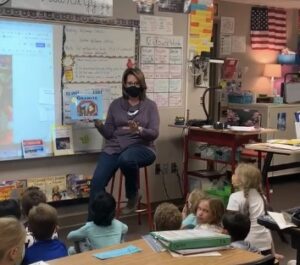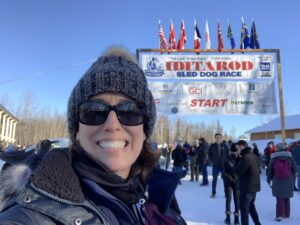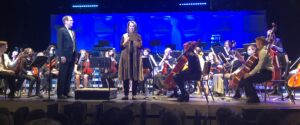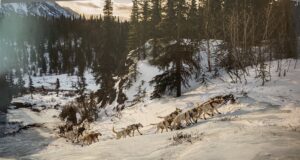Before my time in Anchorage as a Teacher on the Trail finalist I taught the Iditarod in my third grade classroom and as a grade level because the stories of mushers and sled dogs, grit and determination and themes such as perseverance, skill, community and compassion weaved in beautifully with my third grade content and principles of social emotional learning. As I spent an inspirational 9 days in Anchorage as a Teacher on the Trail finalist and worked first hand with Iditarod, the many perspectives I had of the Iditarod Race and of the Iditarod organization were strengthened and deepened as I saw behind the scenes of the world’s greatest race. I gained new perspectives that have impacted what I understand about the race, how I want to teach about the race, and how the race is a model of community, volunteerism and state pride.
One way I was impacted as I took dog handling training and worked a shift in Race Comms was discovering how many volunteers it takes to run the Iditarod Race. When you think about it, the Iditarod is not a business that sells something and it’s not a company. It’s an event that happens once a year. It’s an event with so many parts to it, it would seem impossible to coordinate. But with inspiration, belief in preserving the sled dog and the historical Iditarod Trail and expertise of so many volunteers, it does happen. Skilled pilots, top notch veterinarians, terrain and trail experts, technology experts along with past Teacher on the Trail educators volunteer countless hours that have sustained this race for 50 years. I’m realizing volunteering for the Iditarod does not just happen during the race. Volunteering is also promoting the event back home.
I had the privilege a week after I got back to Colorado to introduce the orchestral piece Iditarod by Soon Hee Newbold at a local high school instrumental music concert. I was so proud to share a bit about my experience of being at the 50th Iditarod as a Teacher on the Trail finalist and made sure every audience member heard that the race was started to remember the Alaskan husky and the sled dog culture and to preserve the old freight and mail trail from Seward to Nome, the Iditarod Trail. Several audience members later thanked me for that background knowledge about the race and I was thrilled that more people know the true meaning and purpose behind the Iditarod Race. As volunteers return home to tell their tale of their Iditarod experience, Iditarod culture is being spread through first hand experiences.
What also impacted me was the stories behind why mushers participate in this race. I loved hearing the announcers at the beginning of the race introduce a musher and share some of their journey as to why they are racing. Mushers so gallantly defer credit to their dogs, their canine athletes, but they are inspirational too! I loved how Matt Paveglio ran the Iditarod to embrace life and make this dream happen because he had the physical health to do it. I loved learning that Brent Sass’s kennel is named Wild and Free after Hobo Jim’s Song and that as a college student he came to Alaska and caught sled dog fever as so many mushers before him. I loved how my heart sank when I learned that Sebastien Dos Santos Borges had to scratch. I learned at the vet check that his dogs flew on an airplane from France and drove across Canada to participate in this race. I knew this was his second attempt at the Iditarod Race and that he loves everyone of his dogs and considers them his friends. Mushers’ stories grab our hearts and enable us to share their dreams and disappointments right along with them.
I was impacted by all the relationships that support mushers and dog teams efforts to race. Iditarod does not only impact the mushers and sled dog teams racing. It is a race that involves communities of people from near and far. Mushers have a huge support group behind them cheering them on. From their families, from their kennels, from their places of work and from classrooms across America and the world, the Iditarod Race does not happen in isolation. I met people at the Winter Education Conference from all over the country who use the Iditarod Race as a way to teach business principles at the university level or as an inspirational unit they enjoy teaching at the elementary level. I also met people who come to Alaska to solely volunteer for the Iditarod organization year after year and have done about every job a volunteer can do! I saw mushers at the Anchorage start patting each other on the back and enjoying casual conversation before the race. Rookie mushers were just as cheered on as veteran mushers when they left the starting line and seeing the new faces of the Iditarod like Amanda Otto being coached by Jeff King shows the ongoing power this race has on past and future generations of mushers and fans. I loved that Mark Nordman, Race Marshal, greets every musher at the finish line in a warm welcome home and I was so touched that each musher’s quest to participate in the race and complete it is honored with a “well done” by Mark, no matter their finishing time or placement.
I was impacted by writing daily posts as a Teacher on the Trail finalist. Looking for “my story” of the Iditarod each day through Iditarod events such as visiting a marshland, watching vet checks and visiting Matt Failor’s kennel to dog handling at the restart created a mission for me to capture photos that can tell the story of Iditarod and inspire lesson ideas for teachers to use. Relying on photos to help guide my writing gave me a new perspective of how to inspire my students to use photos when they write.
On my first day back in the classroom with my students after my 9 days in Alaska, I projected a picture from Jeff Schultz’s Icons of the Iditarod book from my document camera and had my students write a realistic fiction piece of what they saw and how their musher might handle the terrain shown in the picture. After having your teacher gone for 9 days and spring break in 3 days, my students were focused and writing which gave me a smile in my teacher’s heart as that is the magic of the Iditarod and how it draws in everyone it touches.
My Teacher on the Trail experience from the start of the application process to the exit interview impacted me as I realized I cannot just keep Iditarod at my grade level. With 3rd graders at my school so heavily invested and educated about the Iditarod, I am inspired to encourage the 4th and 5th grade teachers at my school to have their students follow the race and cheer on new and favorite mushers each year, with the aim of making lifelong Iditarod followers and future mushers or volunteers out of them!
Finally, I was impacted that no matter how much technology fills our lives, there is no replacement for living wild and free and living in harmony with nature. The Iditarod Race inspires people to fulfill dreams and respect and appreciate nature through working together to save the sled dog culture and a historical trail that built a state. Respecting each state’s story and traditions is what the Iditarod inspires for each of us. Iditarod is everyone’s adventure race and reminds us to challenge ourselves, think of others, embrace nature, celebrate character, honor and remember history, value community and enjoy the ride of life. That impact gives Iditarod a bright future as a race, and as an organization.

And with the Teacher on the Trail program, Iditarod will continue to ignite the passions of future volunteers and mushers in classrooms where a teacher pulls out a book about Togo or Granite and captivates another generation about Alaska’s Greatest Race.
Teachers: Reflections and questioning are so good for personal growth and class growth. Here are some reflection and application questions to ask as you wrap up the race results with your students.
- What lessons or activities got you most ready to watch and understand the Iditarod race?
- Which part of watching the race impacted you and why?
- Which award is most important to you and why do you think that?
- Create end of year awards based on Iditarod awards such as Most Inspirational Student, Most Improved, Student, Kindness Award, and Sportsmanship Award. Teachers can create these or students can create them.
- What activity do you want to challenge yourself to do and why? Why would it be hard and why would it be good for you to persevere and give it a try?
- What is one story about your state that preserves its history and culture?





